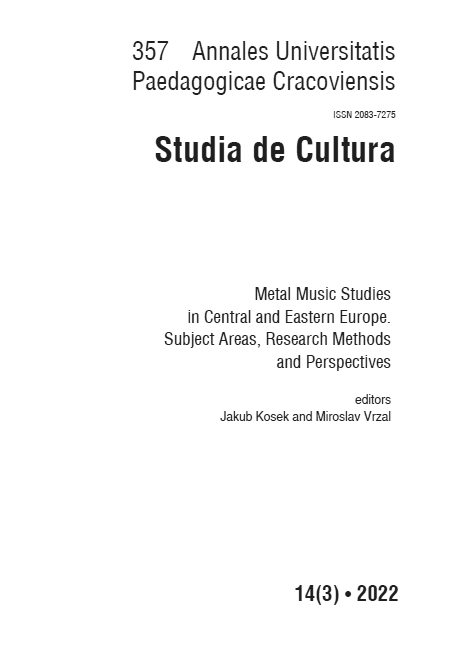Abstrakt
Niniejszy artykuł stanowi studium przypadku programu lirycznego węgierskiego zespołu metalowego Dalriada. Przeprowadzono badania metodą close reading, które opierały się na ideach zaczerpniętych z badań nad recepcją, metal studies, historii i literaturoznawstwa w celu zrozumienia reinterpretacji elementów węgierskiej historii przez zespół Dalriada (np. postaci średniowiecznych, okresu okupacji osmańskiej), tradycji ludowych (np. pieśni ludowe) i literatury wysokiej (dzieła Jánosa Arany’ego). W interpretacjach zauważono pewne wspólne wzorce, pojawiające się w całym dorobku artystycznym grupy.
Bibliografia
Bakos Márton. 2008. Tájnyelvi hangfelvételek – Bukovináról Magyarországra 2. http://mek.oszk.hu/05700/05747/ (acccess: 24.01.2022).
Zobacz w Google Scholar
Benedek Elek. 2015. Székely Tündérország: Székely népmesék és népmondák. Cluj Napoca.
Zobacz w Google Scholar
Benedek Marcell. 1970. Arany János. Budapest.
Zobacz w Google Scholar
Bóna István. 1993. A hunok és nagykirályaik. Budapest.
Zobacz w Google Scholar
Cory C. Lara. 2017. “Interview with Wardruna”. The Quietus. https://thequietus.com/articles/22265-e inar-selvik-wardruna-interview (access: 23.11.2019).
Zobacz w Google Scholar
Constantin Marin. 2012. “Ethno-Historical Traditions Among Minority Ethnic Groups in Romania in the 2000S”. Études balkaniques no. 1. 26–42.
Zobacz w Google Scholar
Dalriada Facebook page. https://www.facebook.com/Dalriadahu/about_details (access: 27.06.2022).
Zobacz w Google Scholar
Dornbusch Christian, Killguss Hans Peter. 2005. Unheilige Allianzen: Black Metal zwischen Satanismus, Heidentum und Neonazismus. Hamburg.
Zobacz w Google Scholar
Elton Geoffrey. 1992. The English. Cambridge.
Zobacz w Google Scholar
Engel Pál, Kristó Gyula, Kubinyi András. 2001. Magyarország története, 1301–1526. Budapest.
Zobacz w Google Scholar
Fejes János. 2017. “Strangers of Popular Culture – The Verbal and Pictorial Aesthetics of Mythological Metal Music”. Acta Universitatis Sapientiae, Communicatio no. 1(4). 37–60.
Zobacz w Google Scholar
Fish Stanley. 1980. Is There a Text in Class? Cambridge.
Zobacz w Google Scholar
Fiske John. 2010. Understanding Popular Culture. New York.
Zobacz w Google Scholar
Granholm Kennet. 2011. “Sons of Northern Darkness: Heathen Influences in Black Metal and Neofolk Music”. Numen no. 4(58). 514–544.
Zobacz w Google Scholar
Györffy György. 1988. Anonymus: Rejtély vagy történeti forrás? Budapest.
Zobacz w Google Scholar
Interview with Ficzek András. Personal communication. (6.09.2018).
Zobacz w Google Scholar
Iser Wolfgang. 1972. “The Reading Process: A Phenomenological Approach”. New Literary History no. 3(2). 279–299.
Zobacz w Google Scholar
János Arany. The Bards of Wales. https://www.visegradliterature.net/works/hu/Arany_J%C3%A1nos-1817/A_walesi_b%C3%A1rdok/en (access: 05.08.2022).
Zobacz w Google Scholar
János Arany: The Two Pages of Sondi. https://www.visegradliterature.net/works/hu/Arany_J%C3 %A1nos-1817/Szondi_k%C3% A9t_apr%C3%B3dja/en/1972-The_two_pages_of_Szondi (access: 05.08.2022).
Zobacz w Google Scholar
Jeles napok – multimédiás oktatási segédanyag. https://jelesnapok.oszk.hu/prod/intro/no8flash.html (access: 24.01.2022).
Zobacz w Google Scholar
Kahn-Harris Keith. 2010. How Diverse Metal Should Be? The Case of Jewish Metal, Overt and Covert Jewishness. In: The Metal Void: First Gatherings. Niall W. R. Scott, Imke von Helden (eds.). Oxford. 95–104.
Zobacz w Google Scholar
Kärki Kimi. 2015. Forging Metal: The Kalevala in the Finnish Heavy Metal Performance. In: Modern Heavy Metal: Markets, Practices and Cultures. Toni-Matti Karjalainen, Kimi Kärki (eds.). Helsinki. 131–137.
Zobacz w Google Scholar
Keresztury Dezső. Arany János. https://mek.oszk.hu/01300/01360/01360.htm#1 (access: 24.01.2022).
Zobacz w Google Scholar
Kovács Árpád. 1982. Táltos. In: Magyar Néprajzi Lexikon (Vol. 5). Ortutay Gyula (ed.). Budapest. 168–169.
Zobacz w Google Scholar
Kristó Gyula. 2002. A székelyek eredete. Budapest.
Zobacz w Google Scholar
Kristó Gyula. 2006. Magyarország története, 895–1301. Budapest.
Zobacz w Google Scholar
Ostrogorsky Georg. 2001. A bizánci állam története. Budapest.
Zobacz w Google Scholar
Patterson Dayal. 2013. Black Metal: Evolution of the Cult. Port Townsend.
Zobacz w Google Scholar
Sándor Klára. National feeling of responsibility: The case of Csángó language revitalization. http://adatbank.transindex.ro/html/cim_pdf438.pdf (access: 24.01.2022).
Zobacz w Google Scholar
Sinkovics István. 1985a. A békeidőszak az 1570-1580-as években. In: Magyarország története: Tíz kötetben (Vol 3/1). Zsigmond Pál Pach (ed.). Budapest. 605–651.
Zobacz w Google Scholar
Sinkovics István. 1985b. Az ország megosztottságának állandósulása (1541–1570). In: Magyarország története: Tíz kötetben (Vol 3/1). Zsigmond Pál Pach (ed.). Budapest. 223–283.
Zobacz w Google Scholar
Spracklen Karl. 2015. “To Holmgard… and Beyond: Folk metal fantasies and hegemonic white masculinities”. Metal Music Studies no. 3(1). 359–377.
Zobacz w Google Scholar
Spracklen Karl. 2020. Metal Music and Re-Imagining of Masculinity, Place, Race and Nations. Bingley.
Zobacz w Google Scholar
The Metal Archives. https://www.metal-archives.com/ (access: 24.01.2022).
Zobacz w Google Scholar
von Helden Imke. 2010. Barbarians and Literature: Viking Metal and its Links to Old Norse Mythology. In: The Metal Void: First Gatherings. Niall W. R. Scott, Imke von Helden (eds.). Oxford. 272–263.
Zobacz w Google Scholar
von Helden Imke. 2017. Norwegian Native Art: Cultural Identity in Norwegian Metal Music. Zürich.
Zobacz w Google Scholar
Weinstein Deena. 2000. Heavy Metal: The Music and Its Culture. New York.
Zobacz w Google Scholar
Dalriada, Kikelet, Nail Records 2007.
Zobacz w Google Scholar
Dalriada, Szelek, Nail Records 2008.
Zobacz w Google Scholar
Dalriada, Arany-album, Nail Records 2009.
Zobacz w Google Scholar
Dalriada, Ígéret, AFM Records 2011.
Zobacz w Google Scholar
Dalriada, Napisten hava, Nail Records 2012.
Zobacz w Google Scholar
Dalriada, Áldás, Nail Records 2015.
Zobacz w Google Scholar
Dalriada, Mesék, álmok, regék, Nail Records 2015.
Zobacz w Google Scholar
Dalriada, Forrás, Nail Records 2016.
Zobacz w Google Scholar
Dalriada, Nyárutó, Nail Records 2018.
Zobacz w Google Scholar
Dalriada, Őszelő, H-Music 2021.
Zobacz w Google Scholar
Echo of Dalriada, Fergeteg, Nail Records 2004.
Zobacz w Google Scholar
Echo of Dalriada, Jégbontó, Nail Records 2006.
Zobacz w Google Scholar
Týr, Land, Metal Blade Records 2008.
Zobacz w Google Scholar

Utwór dostępny jest na licencji Creative Commons Uznanie autorstwa – Użycie niekomercyjne 4.0 Międzynarodowe.

